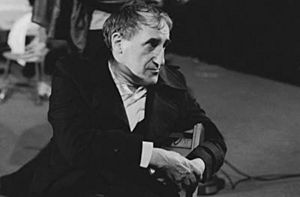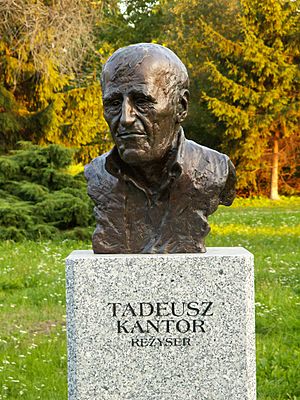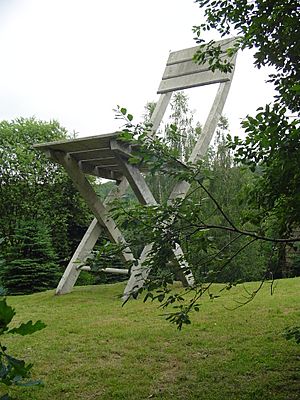Tadeusz Kantor facts for kids
Quick facts for kids
Tadeusz Kantor
|
|
|---|---|

Tadeusz Kantor
|
|
| Born | 6 April 1915 Wielopole Skrzyńskie, Austria-Hungary
|
| Died | 8 December 1990 (aged 75) |
| Nationality | Polish |
| Occupation | Theater director, artist |
|
Notable work
|
Dead Class |
Tadeusz Kantor (born April 6, 1915 – died December 8, 1990) was a famous Polish artist. He was a painter, a sculptor who made art from different objects, and a performance artist. He also designed sets for plays and was a brilliant theatre director. Kantor became very well-known for his new and exciting theatre shows, both in Poland and around the world.
Contents
Who Was Tadeusz Kantor?
Tadeusz Kantor was born in a place called Wielopole Skrzyńskie, which was part of Austria-Hungary at the time, but is now in Poland. He finished his studies at the Cracow Academy in 1939.
During World War II, when Poland was occupied, Kantor started a secret group called the Independent Theatre. From 1942 to 1944, he also taught at the Academy of Fine Arts in Kraków. He directed experimental plays in Kraków during this time.
After the war, Kantor became famous for his unique stage designs. He created sets for plays like Saint Joan (1956) and Measure for Measure (1956). He did things that were very new for theatre. For example, he made stages that reached out into the audience. He also used mannequins (like store display dummies) as if they were real actors in his shows!
Cricot 2 Theatre Group
In 1955, Kantor started a new theatre group called Cricot 2. He formed it with other artists who wanted to try new things in art. In the 1960s, Cricot 2 performed in many theatres in Poland and other countries. They became known for their "stage happenings," which were like live art performances.
Kantor was very interested in plays that explored "absurd" ideas. These plays often showed life as strange or without clear meaning. He especially liked the works of a Polish writer named Stanisław Ignacy Witkiewicz. Kantor's plays based on Witkiewicz's The Cuttlefish (1956) and The Water Hen (1969) were considered some of his best. A show of The Water Hen in 1972 was a big topic of conversation at the Edinburgh festival.
Dead Class and Later Works
One of Kantor's most famous theatre pieces from the 1970s was Dead Class (1975). A TV movie of this play was even made in 1977. In Dead Class, Kantor himself played the role of a teacher. He was in a classroom with characters who seemed to be dead. These characters then faced mannequins that looked like their younger selves. Kantor had started trying out using both mannequins and live actors together in his plays back in the 1950s.
His later works in the 1980s were very personal. Just like in Dead Class, he would sometimes appear on stage in his own plays. In the 1990s, his works became well-known in the United States. This was thanks to shows at Ellen Stewart's La MaMa Experimental Theatre Club.
Tadeusz Kantor had a special connection with Jewish culture. Even though he was Catholic, he included many ideas from "Jewish theatre" in his art.
Tadeusz Kantor passed away in Kraków. In 2014, a new center called Cricoteka opened in Krakow. It is dedicated to showing and documenting Tadeusz Kantor's amazing art.
Important Ideas and Plays
Tadeusz Kantor wrote down many of his ideas about theatre. Some of his important writings include:
- The Autonomous Theatre (1963)
- Theatre Happening: The Theatre of Events (1967)
- The Theatre of Death (1975)
Here are some of the plays he created with his Cricot 2 group:
- The Cuttlefish (1956)
- The Water Hen (1965)
- The Dead Class (1975)
- Wielopole, Wielopole (1981)
- I Shall Never Return (1989)
See also
 In Spanish: Tadeusz Kantor para niños
In Spanish: Tadeusz Kantor para niños
- Culture of Kraków



